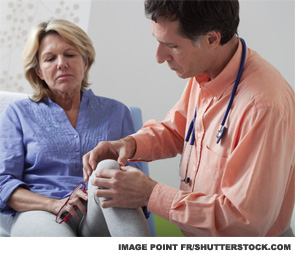
Osteoarthritis (OA), the most common form of arthritis, can be viewed as a chronic condition; however, it is seldom approached as such. Although risk factors for other chronic conditions, such as diabetes and heart disease, are generally screened for during a routine physical exam, OA is not.
The joint pain of OA is frequently perceived as an inevitable part of aging, so patients and healthcare providers tend to tolerate it until the condition has progressed to the point that joint replacement is accepted as the only treatment.
Early detection can lead to treatment that may prevent the disease’s progression to its not-inevitable disabling consequences. Screening for such risk factors as obesity, genetics, joint injuries and trauma may even prevent OA.
COAMI
To help change and improve the current approach to managing OA, the U.S. Bone and Joint Initiative convened a Chronic Osteoarthritis Management Initiative (COAMI) Work Group in May 2012 in Chicago.

Toby King, executive director of the U.S. Bone and Joint Initiative, says “a number of executive board members thought the time was right to change the paradigm of OA care. To make it more proactive, than reactive.” He says it was a swift decision because this was an “issue that needed to addressed.”
A product of the Work Group was the Call to Action, advocating for a change in the paradigm of intervention (see http://www.usbji.org/sites/default/files/COAMI%20Call%20to%20action.pdf).
With little time devoted to education about OA, healthcare providers’ lack of awareness of the condition is a significant missed opportunity. Typically, there is no multidisciplinary approach to OA. There should be screening tools or questions tested in different settings. The Call to Action also states healthcare providers should have “basic tools to gauge levels of risk, disability, pain or loss of function.”
The Work Group also identified other actions to increase healthcare providers’ awareness of OA. They included:
- Convening an OA management conference that would, in part, “address the incomplete and inconsistent approaches to managing OA”;
- Reaching out to other partners for inclusion in future COAMI work, such as practitioners in weight management, nutrition and sports medicine;
- Exploring standardizing screening tools and indicators of OA to make early diagnosis more consistent and likely;
- Developing tools and prompts to engage patients in learning about and managing OA;
- Lending COAMI’s support to existing advocacy and awareness efforts; and
- Developing and supporting an OA-specific research agenda.
The Work Group was expanded in September 2013, and the Osteoarthritis Management Conference started developing a model of care. COAMI hopes to make early screening, detection, intervention, ongoing monitoring and comprehensive care models an integral part of medical care.

